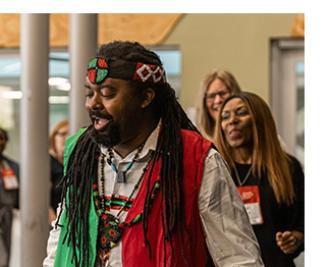Delegates representing the 11 Canadian classes of the Christian Reformed Church in North America, and those from the Canadian portion of the one binational classis, met together with senior ministry leaders, Indigenous Christian leaders, and other invited church members at a national gathering May 25-28 at Ottawa’s Algonquin College. The agenda for this third national gathering for Canadians in the CRCNA focused on matters of justice and reconciliation with Canada’s Indigenous peoples. It followed up on the concerns for Canada’s native peoples raised at the last national gathering at The King’s University in Edmonton, Alta., in 2019.

More than 30 people led workshops, took part in panel discussions, told stories, presented a drama, and served as session or worship leaders. In the conference opening address, Adrian Jacobs who serves as the CRC’s senior leader for Indigenous justice and reconciliation in Canada, told the story of the Two Row wampum covenant. In 1613 when a trading ship from the Netherlands made first contact with Haudenosaunee people in what is now upstate New York, the two peoples made an agreement to peacefully trade goods. Native artisans recorded the agreement by making a wampum belt with two parallel rows of blue beads surrounded and separated by rows of white beads. Jacobs challenged the gathering to renew this early relationship of friendship between two very different peoples. This challenge was symbolically taken up by two artists, one Indigenous (Lorrie Gallant) and the other “settler” (Becky Jones), who were tasked with reproducing the wampum belt imaginatively on canvas. The finished large canvas painting of a renewed Two Row Wampum covenant will be framed and hung on display at the CRCNA’s Canadian ministry office in Burlington, Ont.
RELATED: Jesus and the Two-Row Wampum Belt, As I Was Saying post by Parry Stelter, Aug. 26, 2022
Different Cultural Lens, New Way of Understanding
An intercultural theology panel considered the question of hearing gospel truth through differing cultural ways of understanding. Raymond Aldred, director of the Indigenous studies program at the Vancouver (B.C.) School of Theology, said, “Western culture evaluates the gospel according to a scientific worldview. It must hear the gospel again through another culture, to evaluate the scientific worldview. Indigenous culture sees the Creator and the creation coming together in perfect harmony.” Bert Adema, executive director of Indigenous Christian Fellowship in Regina, Sask., used a metaphor of an apple tree: “Jesus is the apple root stock. Different cultures are like the many varieties of apple whose branch stock must be grafted into this root and stem.” Amanda Benckhuysen, who works for the denomination in the area of Safe Church, observed that Revelations 21:24 has the kings of the earth bringing their cultural treasures to the throne of God—not one king, but more, representing separate cultures. “How can we, with our white theology, learn to love God cross-culturally?”
Worship throughout the gathering evidenced the will to love God cross-culturally, in a hearts-exchanged way. (Hearts Exchanged is a CRC-developed co-learning commitment experienced by many Canadian CRC members over the past three years and was the thematic focus of the May 2023 gathering.) Jonathan Maracle, founder of the Indigenous musical group Broken Walls, led opening worship on Thursday pounding a large buffalo hide drum and chanting a rhythmic syllabic song. A praise team led by worship leader Ruth Ann Dykstra Schuringa joined in with guitars and voices, chanting along in harmony to the syllabic sounds projected onto a screen. The chant transitioned into a prayer to Yeshua (Jesus), more chanting, then moved into worship songs and choruses more familiar to most of the people at the gathering. Many in the room joined hoop dancer Kenny Wallace, dressed in red and green with beadwork accessories, in his rhythmic dance around the hall. Wallace (Aboha ‘a Chihowa) is an African American Choctaw Pawnee from the United States living in Canada.
That flow between the two styles of music, playing and singing together, did seem to give participants the experience of praising God in a whole new way. “I have not had a non-native worship team join with me in worship ever before,” Maracle said. “It was a cool experience, seeing the joyous expressions of the worship team doing something new.” Dykstra Schuringa said, “I think that was one of the best things I have ever experienced in my life.”
About the Author
Ron Rupke is a freelance news correspondent for The Banner. He is a member of the Fellowship CRC in Brighton, Ontario.

